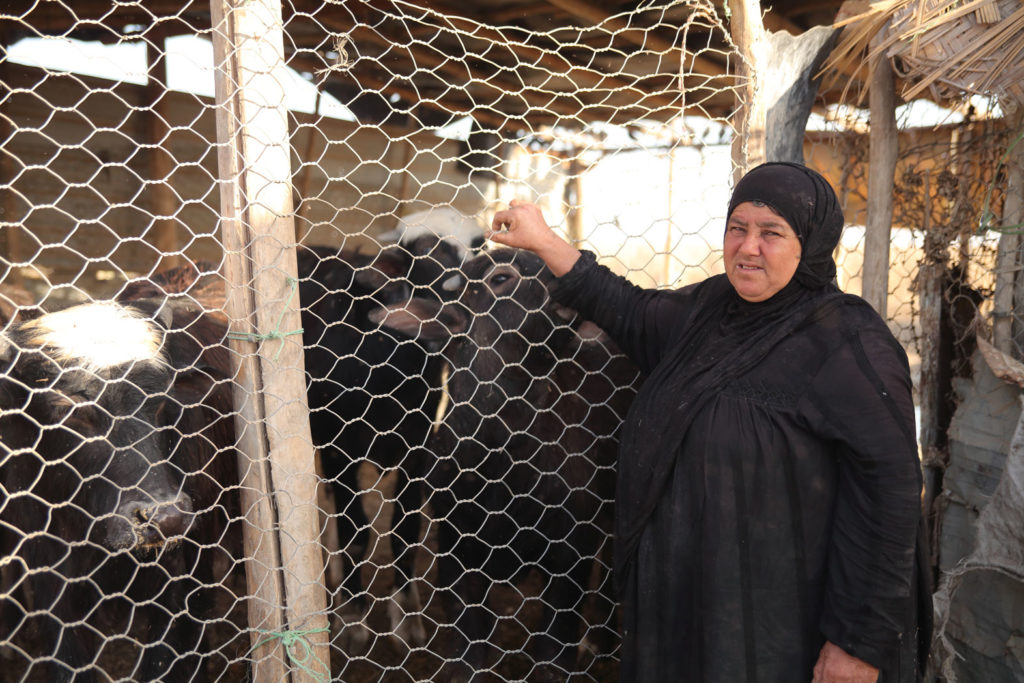
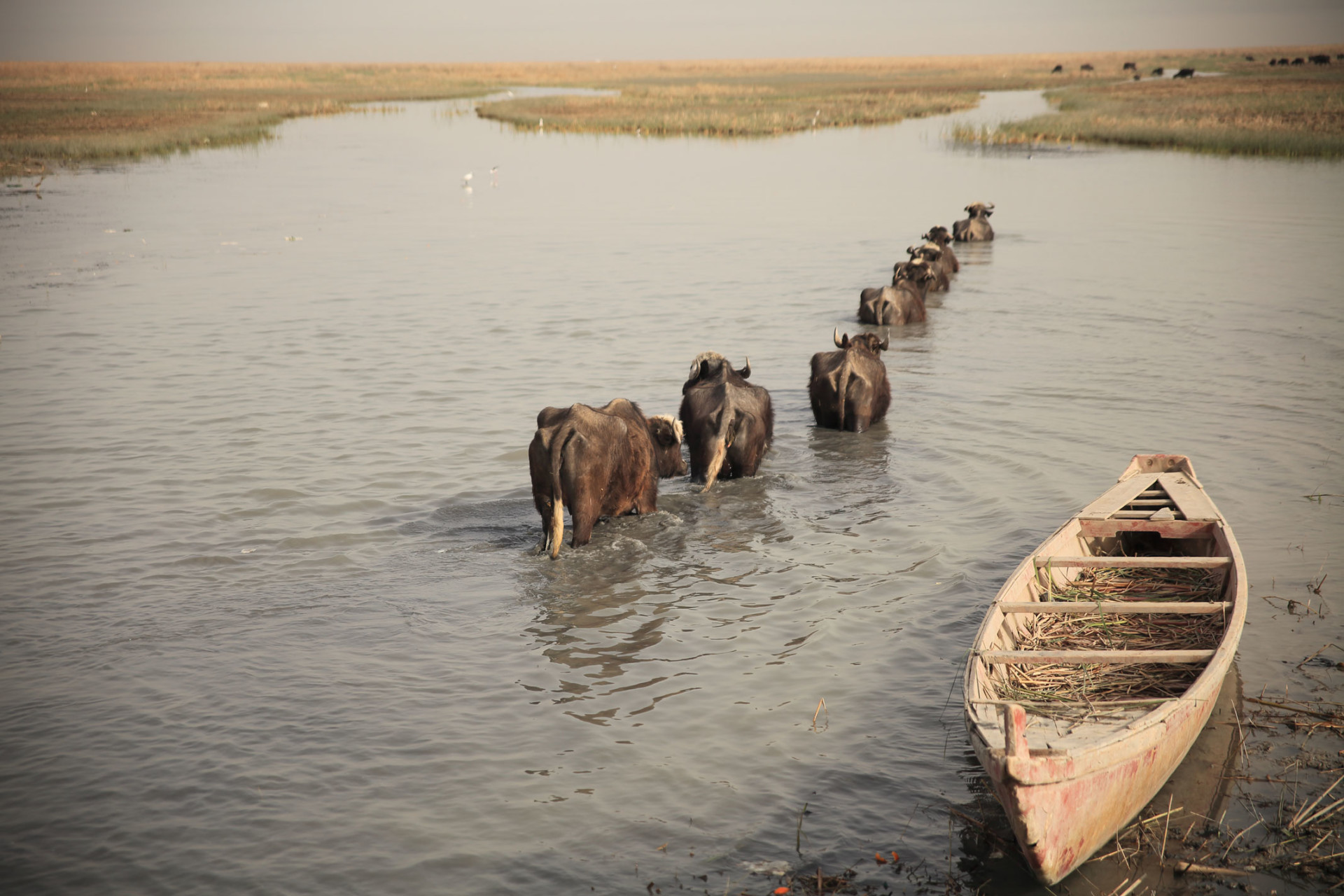
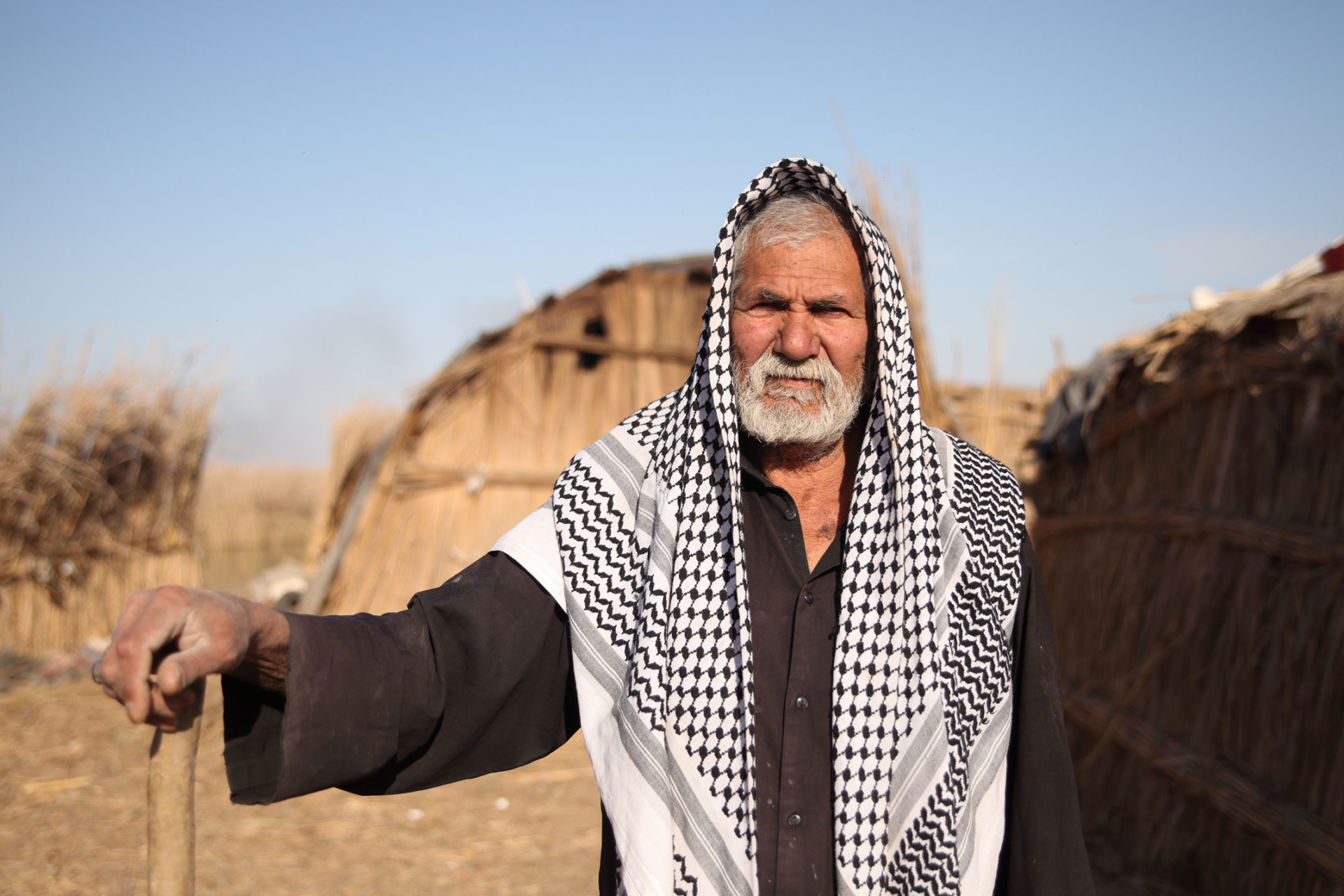
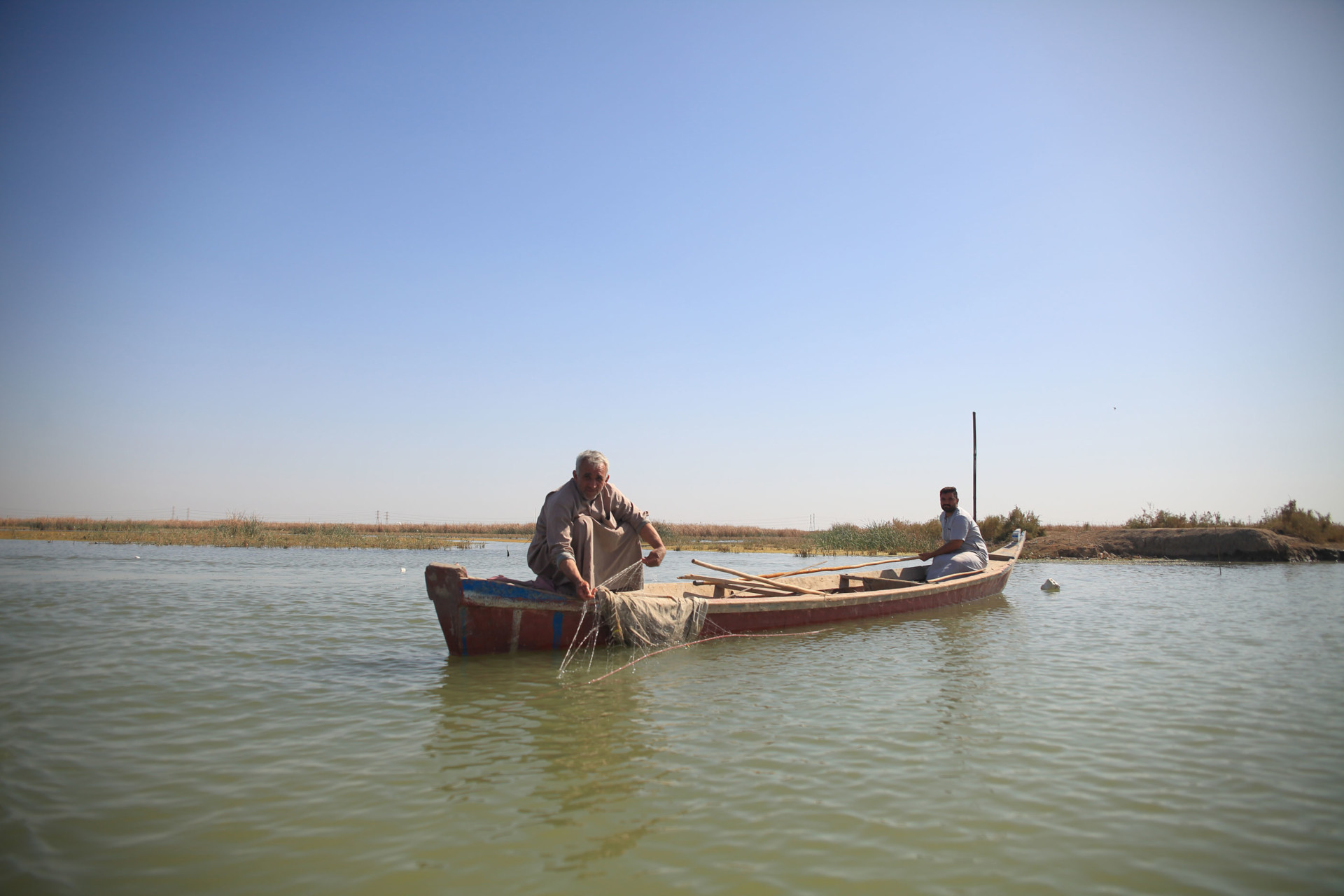
Desertification in an Iraqi Bread Basket
The Iraqi region is in critical condition as water resources dry up and sandstorms dominate the skyline
Palm branches whip back as Hussein Ibrahim walks through his densely planted land in Al Fao, the very last village in Iraq’s south as it reaches the Persian Gulf. Affectionately known as Abu Yusuf in reference to his eldest son, Ibrahim explains that farming is his culture.
“I’ve inherited this land from my grandfather and even the father of my grandfather had it. We were all farmers; we were born to be farmers,” says the father of seven as he picks a pomegranate from a tree on his five acres, set in a place believed by some to be the biblical Garden of Eden, or perhaps, the first place Adam and Eve descended on Earth.
But as he walks around gently touching each of the date palms, henna and sidr trees – also believed by some to have borne the first fruit that Adam and Eve ate after their fall to Earth – Ibrahim says that only one third of his land can now be farmed.
In the past, ships came up the Shatt-al-Arab River from the Gulf to Al Fao, where their crews would load dates and ferry them around the world. The Basra region, where Al Fao is situated, has always been a bread basket of Iraq. But now because of immense salinization of lands, a decrease of water flow into vital rivers due to upstream damming, climate change and pollution, many farmers are losing the battle to keep their crops alive, and people dependent on fishing and buffaloes in the Iraqi marshlands are in competition for food.
The majority of the lands surrounding Ibrahim’s house and farm are either dirt brown or white from a crusty layer of salt that sits on the surface. The wind is dry and suffocating, and the horizon shimmers with pulsing heat. Ibrahim says it was in 2019 when the rainfall became dire; in one year, half of the green land was lost.
“My father had 150 date palm trees and we lost all but ten here,” he says, as he gestures to a palm tree, adding that there will be no dates this year. “None of these palm trees will have fruit this year, because the buds are not coming out to be fertilized.”
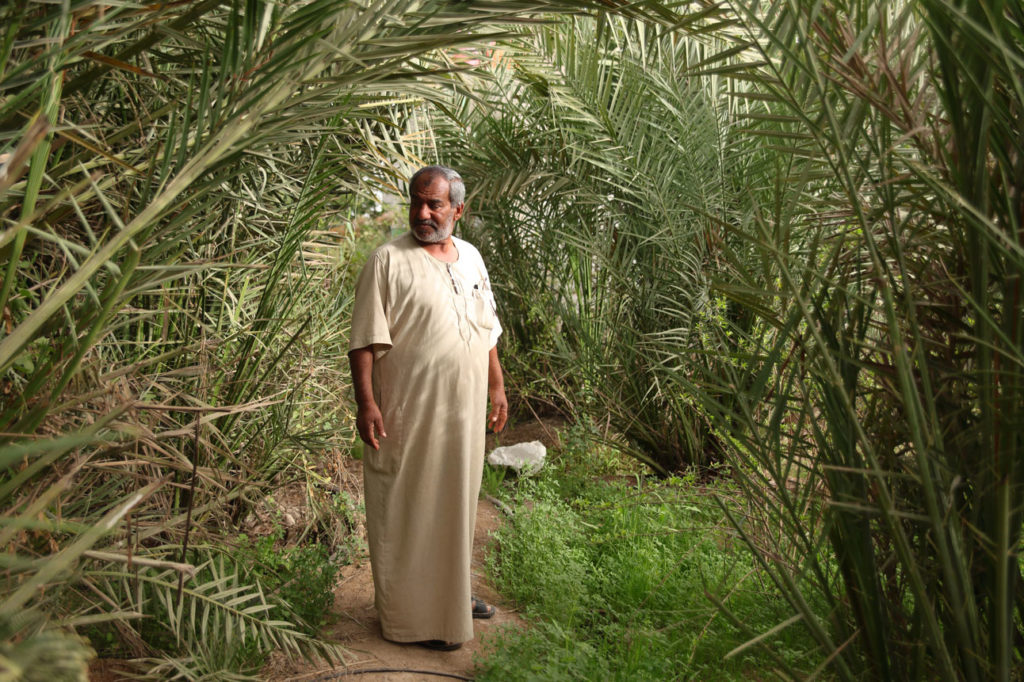
As Azzam Alwash, personal adviser on climate change to the president of Iraq, says, life in southern Iraq is completely dependent on water, which is becoming increasingly scarce. Historically, the region and natural systems thrived because of the annual flood season. The Iraqi marshlands served as the natural retention basin, which contained the water of the Tigris and Euphrates in the flood season when the snow in the Iraqi Kurdistan mountains started to melt in the spring. Irrigated agriculture via human-made canals from the rivers was sustainable in Basra due to the continuous presence of water in the region. “The water of the floods would come in, wash away the salts that accumulated from the year before, and deposit a layer of clay on the farmland, renewing the productivity of the soil,” explained Alwash, who is also the CEO and founder of Nature Iraq, an NGO working in Iraq and in the Kurdistan Region, accredited by the United Nations Environment Programme.
This natural system began to break down when dams and lakes were built to protect the populated areas from floods.
“Engineers started thinking they are smarter than nature,” says Alwash. The best example is Tharthar Lake, which opened in 1956 in the middle of Iraq’s two most important rivers, the Tigris and the Euphrates. This lake prevents the floodwaters from refreshing the agricultural lands, which historically has prompted fish to spawn. Instead, about 2 trillion gallons of floodwater a year is being lost to evaporation from the lake.
“From that lake we evaporate more water than the entire water budget of a country like Jordan,” Alwash exclaims. “You add up all the other lakes and dams, and all the exposed canals used to transport water around southern Iraq, and I can tell you Iraq loses around 3 trillion gallons of water a year.” For context, in one of the world’s longest rivers, the Nile, about 79 billion gallons of water flows on average on any given day.
Adding to this loss of water is the damming upstream by Iran and Turkey of Iraq’s vital rivers, which, in some cases, has completely ceased the flow of water into Iraq. Dr. Shukri Al Hassen, a Basrah University academic and environmentalist, says the amount of water flowing from Iran into the rivers of Iraq is now almost zero, since Iran has diverted 42 tributaries in the last 20 years. The two most important rivers that flowed into Iraq from Iran were the Karkheh and Karun, which the Islamic Republic dammed in 2001 and 2007 respectively. Turkey has also been building dams on the Euphrates and Tigris since the 1970s, but the Southeastern Anatolia Project (GAP) is by far the most harmful to Iraq’s water sources.
Ali Al Karkhi of the Humat Dijlah, an NGO working to save the Tigris and its marshes, criticizes the Iraqi government for not taking action against Turkey and Iran in order to regulate its access to about 70% of the rivers’ waters.
“It’s the responsibility of the government to open negotiations to guarantee that water arrives to all Iraqis, including the Iraqi marshlands. It is also an international responsibility to support Iraq as it faces Iran and Turkey,” Al Karkhi says. Iraq’s Minister of Water Resources, Mahdi Rashid Al Hamdani, announced last year the government would file a lawsuit at the International Court of Justice against Iran because of the cut in water access, though this has yet to happen.
“Even if Iraq won a judgment against Iran, you wouldn’t be able to enforce it … because the Baghdad decision is controlled by Iran,” Alwash says.
The nearby Shatt-al-Arab is the source of water for the irrigation canals of Ibrahim’s farm, but now the current of the river isn’t strong enough for it to water the land. Three years ago, Ibrahim would harvest about 600 pounds of henna every 40 days, but now he collects about one third of that, which barely covers the cost of the operation. In the same period, he lost 46 pomegranate trees because of a lack of water and salinity; he has only four left.
As the flow from the Tigris and Euphrates into the Shatt-al-Arab continues to decrease, sea water from the Persian Gulf encroaches on the freshwater river, which has seen an alarming increase in salinity since 1970. According to Al Hassen, the river water in Basra tends to be six to 15 times more saline than it was in the 1970s.
When people chose to stop the natural flood cycle, modern irrigation practices such as drip irrigation for vegetables would have sustained farms. Since no change in farming techniques has been made in Basra, however, current irrigation methods have only added to the salinization of the soil. When the entire soil is saturated through flood irrigation, it forces the groundwater to rise, bringing salts to the surface. These salts are then drained back into the very river used to irrigate, thereby further increasing the salinity of the river — a toxic cycle that has the authorities throwing up their hands in despair.
Dia Ismail, head of environment and climate change at the Ministry of Agriculture in Iraq, says the cause of greater salinity in Basra is water scarcity. “What [would] change if we change the irrigation [methods] when the water there is already salty?” Ismail says.
Ibrahim, who is now 61, remembers growing up in a region that was lush and filled with life and community. “Almost 70 families here had similar farms like mine; more than half of them gave up because there’s no more benefit from the land,” he says sadly. With the exception of a couple of villages, Al Fao has been affected more dramatically than other areas in Basra by the salinity and lack of water, according to Abd Al Hussein Al Abadi, head of the Federation of Farmers Association in Basra.
“They’re very affected, especially from 2018 and 2019, when there was a very obvious wave of salinity,” says Al Abadi from his office in Basra city. “A lot of farmers lost a lot of production and land.”
The abandonment of agricultural farms, leaving the land barren and unplanted, is creating a rapid desertification of the Basra region, a process that itself contributes to climate change and an increase in temperatures. Al Karkhi points out that temperatures were not historically this high; otherwise people wouldn’t have built large population centers like Basra.
“This is an exceptional situation because of climate change, which is accelerating as a result of all the damage that we are imposing on the environment,” he says. Most of the agricultural lands in Al-Fao and Al-Siba, part of the lands in Abi Al-Khaseeb and Shatt Al-Arab district, and large parts of the agricultural lands in Al-Deir and Al-Haritha have been lost because of salinization.
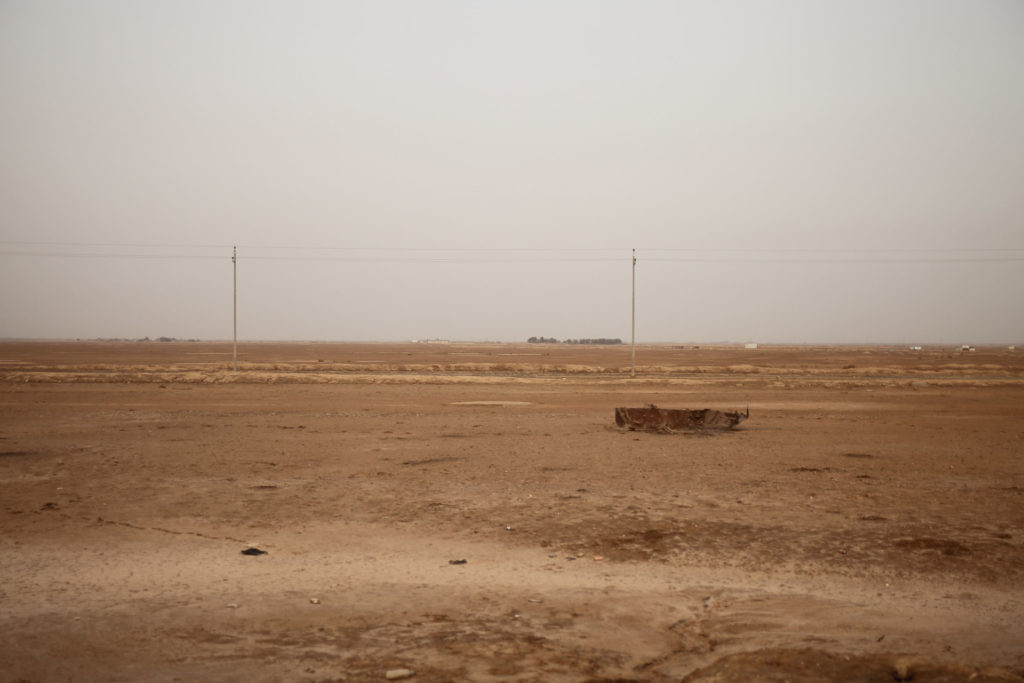
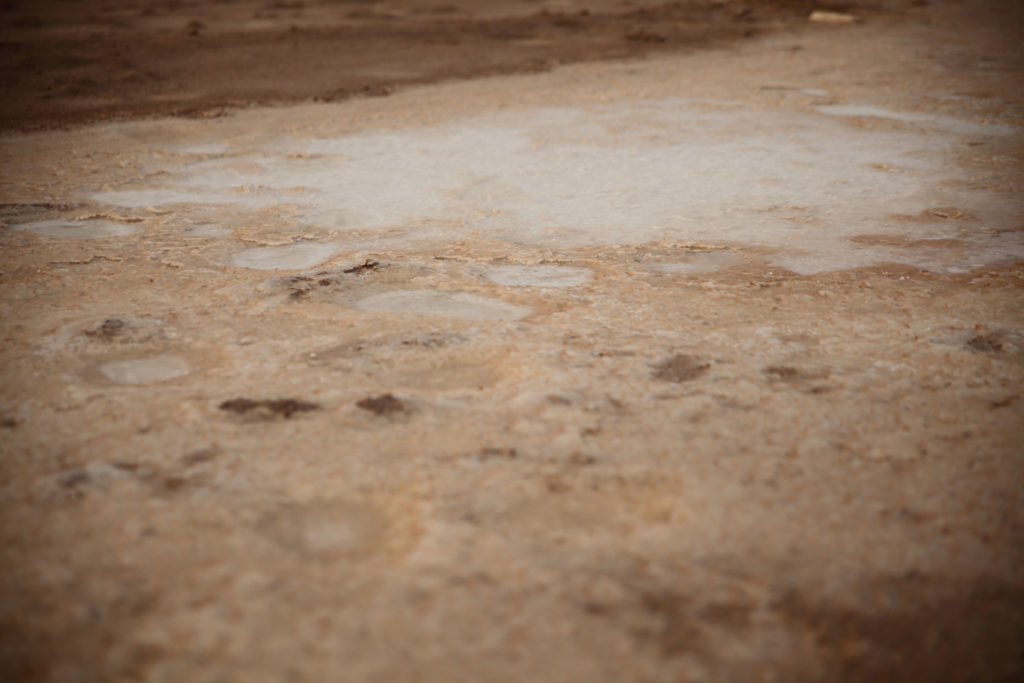
Iraqis are already living through the extreme weather events that climate change can bring, one of them being greater frequency of sandstorms. Historically, April is known as the month when the skies turn orange and strong winds carry dust from the desert, but now the storms roll into the next month and continue with greater intensity and harm. In 2022 alone, at least 10,000 people have been hospitalized and one person has been killed because of the storms in Iraq. The dust is suffocating, leaving even the healthiest person waking up in the morning and coughing up dirt for half an hour. The coughing often lasts for weeks, and people’s eyes are itchy even in their own homes where dust seeps in through the slightest crack, coating every surface.
Dr. Mohammed Foud, a specialist in respiratory disease at Basra General Hospital, says that most cases coming into the hospital during the sandstorms are people with acute respiratory illnesses, severe sinusitis or an exacerbation of existing conditions such as bronchial asthma and lung fibrosis.
“Any exacerbations which lead to hospital admission will affect the long-term control of the problem and the [greater frequency] will cause a higher mortality rate for the chronic illnesses like bronchial asthma and COPD [chronic obstructive pulmonary disease] patients,” Foud says. Patients who were previously healthy may also suffer from asthma-like symptoms for years, or even for life. Foud is already concerned by the increased sandstorm exposure people have faced this year. “If the weather conditions stay the same, the progression of the sandstorm in the next few years will definitely leave an impact on the public health system.”
Up until a few decades ago, Iraq would experience a storm or two in a year, during the winter season. However, this year, the country has seen more than 10 sandstorms since April. Desertification and decrease in rain are aiding the intensity of the storms, as barren and fragile soils are picked up by winds that are stronger than usual, at 15 mph or more. The average wind speed in the alluvial plain of Iraq ranges from 6 to 9 mph. Studies say that in Iraq, the separation of soil particles from the surface only takes place when the wind speed is 15 mph or more. It’s understandable that a wind of that speed is not considered to be strong enough when compared to thunderstorms and cyclones, but the small size of the soil particles, its dryness and fragility makes it capable of moving and turning into a dust storm or sandstorm.
Al Hassen explains that the winds are faster because of the advance of a polar air mass toward the region. “The descent of the heavy cold air mass leads to the rise of the light warm air mass, and this thermal variation is sufficient to cause rapid movement of winds and raise dust,” he says.
Heading north along the Shatt-al-Arab River from Al Fao, the area is desolate: not a speck of green can be seen on either side of the road, and large craters of salt lie in what were once fields. Reaching the village of Abu al Khaseeb, the gentle 50-year-old farmer Qasim Abdul Wahad walks to the edge of his 2.5-acre farm, planted with palm trees, henna, okra, tomato and eggplant, and points to the polluted river water that now doesn’t reach high enough to irrigate his land. “Now I have to use the public water network that goes to houses for the farm,” Abdul Wahad says.
“The salinity of the soil is affecting each single tree; I can see it. Instead of giving four flowers on each, it only has two buds,” Abdul Wahad explains, saying he barely makes a profit from his land, which is his family’s sole income. In the 1970s, he remembers, students from the University of Basrah would come to relax in the lands of Abu al Khaseeb. But now everything is just dust.
The Ministry of Agriculture notes its moves to forestall desertification, which include: “encouraging farmers to expand cultivation of salt tolerant crops such as tomatoes, which have proven highly productive in these conditions; attracting companies which work with the ministry to import modern irrigation systems to reduce water loses; instructing departments and offices to develop new varieties that are tolerant to salinity and drought, and; the free distribution of salinity and drought tolerant fruit tree varieties in coordination of the directorates of agriculture in the southern provinces, such as date palm.” However, Abdul Wahad and Ibrahim, as well as Al Abadi, all say that tomatoes and date palms are also suffering in these extreme conditions. New varieties of seeds that are being developed mainly focus on wheat, which is a water-heavy crop.
North of Abu al Khaseeb, the lives of those living in the Iraqi marshlands are also deeply affected by the water crisis. Al Karkhi from Humat Dijlah says that the marshes are at a critical moment. “If Iraq, Iran and Turkey continue damaging the Iraqi marshes, thousands of Marsh Arabs will not be able to practice their usual lifestyle which they have been doing for thousands of years,” Al Karkhi says. “What Saddam did in 1991, we continue doing it,” he added, referring to Saddam Hussein’s punishment against the Marsh Arabs following the Iran-Iraq war, when he drained the marshes and accused Marsh Arabs of treachery.
According to the research undertaken by Khafaja Ahmed Mays, an assistant professor at Baghdad University, the total area of the marshes was 2.3 million acres in 1976. After Saddam drained them, the level had decreased by more than 90% in the year 2000. After the fall of Saddam in 2003, they were slowly reflooded following the dismantling of drainage networks by the Marsh Arabs themselves and the new government, but by 2013 they had barely recovered to 40% of what they used to be and have only continued to deplete since then.
Navigating through the narrow causeways of the marshes, the “mashuf,” or long canoe, pushes through tall reeds that overgrow the path known only to locals. Water buffaloes stand by the banks or appear out of nowhere as they swim through the water while local fisherman cruise by, waving with bright smiles. Further on is Thama Hatahat’s house, weaved of marsh reeds and perched on a small island, seamlessly blending into its surroundings.
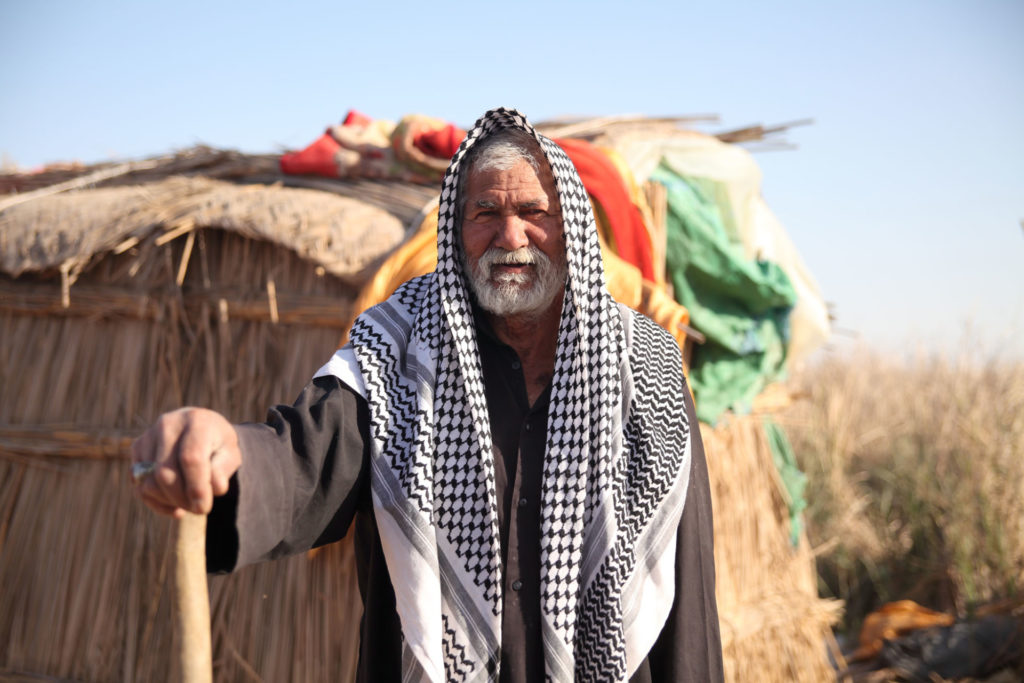
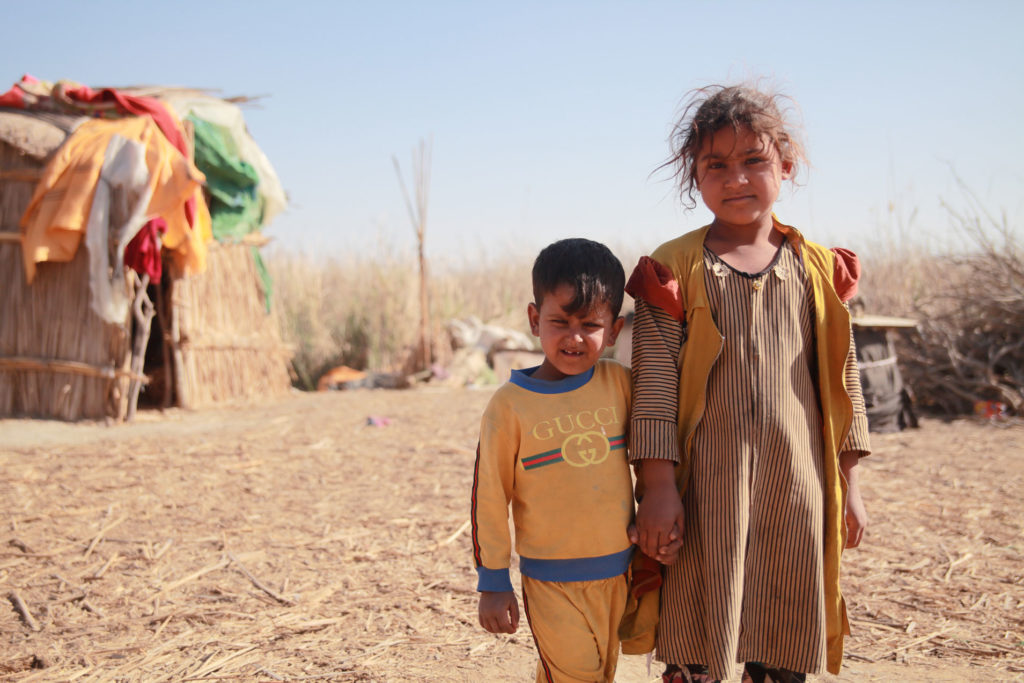
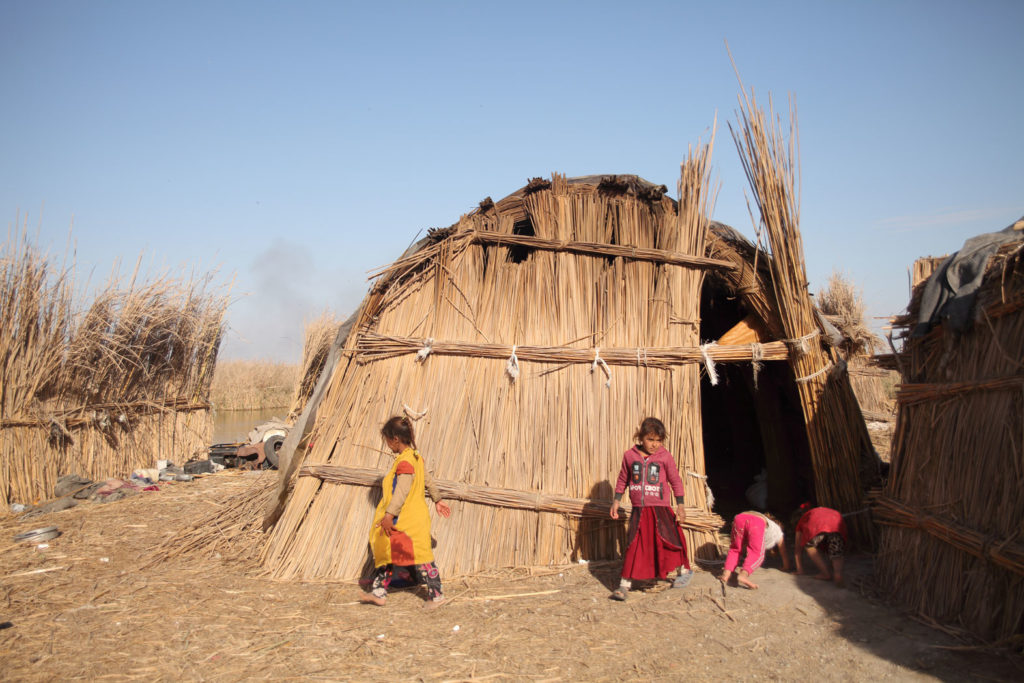
Unsure of his age, Hatahat, who introduces himself as Abu Mohamed, takes a guess that he’s 41, though he looks older. “We have been here since Adam and Eve,” he says, speaking of his family’s many generations, as his 12 kids gather around him. His family, like the majority of people in the marshes, are dependent on the water for their buffaloes and to catch fish. Each morning the buffaloes are sent out from their enclosures into the marshes to graze, but now they come back hungry. His family is facing a “crisis,” as Hatahat says, because they need to buy $40 worth of feed every day to sustain their 30 buffaloes. “They can’t eat the grass from the marshes anymore, because the water is poisoned,” Hatahat explains, as one of his sons pours tea.
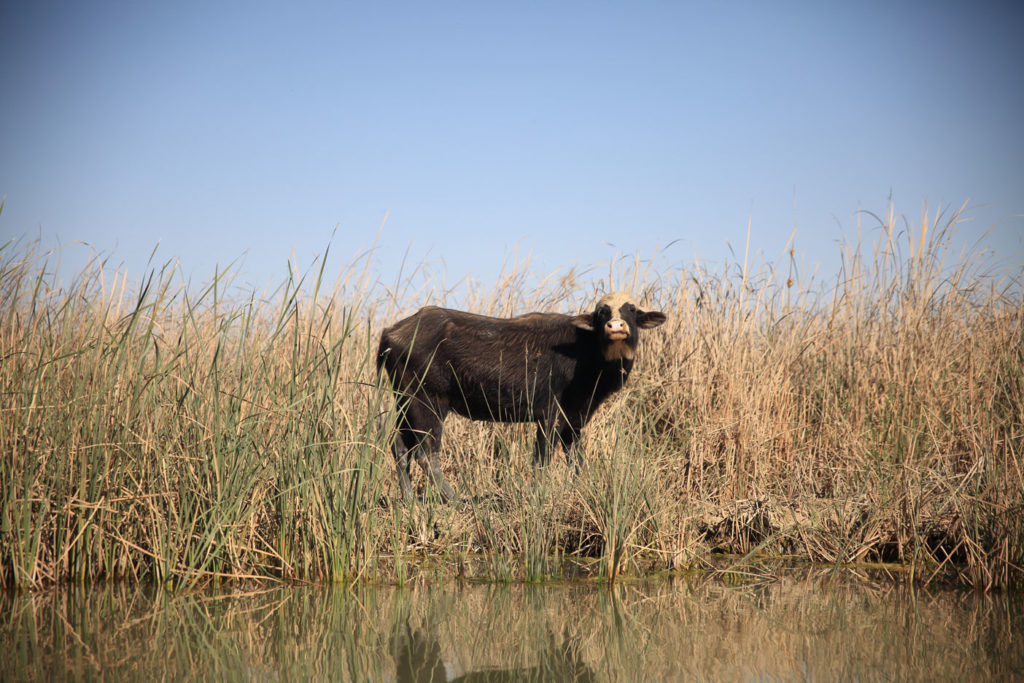
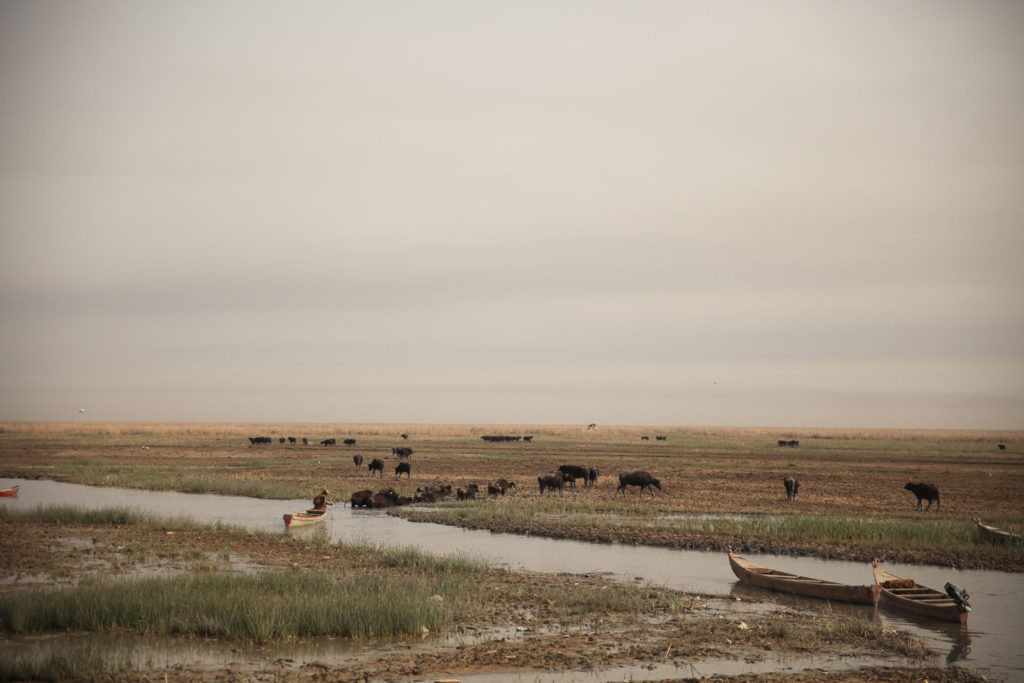
Typically, Hatahat’s family sells fish they catch in order to make a living, as well as buffalo milk and cream which is eaten traditionally at breakfast, but now all their income goes to feed. “It’s like we’re selling the dairy products of the buffalo just to keep them alive,” Hatahat laments. Noor, one of Hatahat’s wives, emerges from the largest reed house — which is rebuilt every three years – and mentions that due to the decrease in water, there are less reeds to collect now to do repair work. The resident representative of United Nations Development Program (UNDP) Iraq, Zena Ali Ahmad, describes the marshland ecosystem as “collapsing,” considering that it is dependent upon flows of fresh water from the Tigris and Euphrates. “Reduced flows in these rivers means less and less freshwater flows into the marshlands, which poses a threat to the sustainability of this World Heritage Biodiversity Site,” Ahmad says.
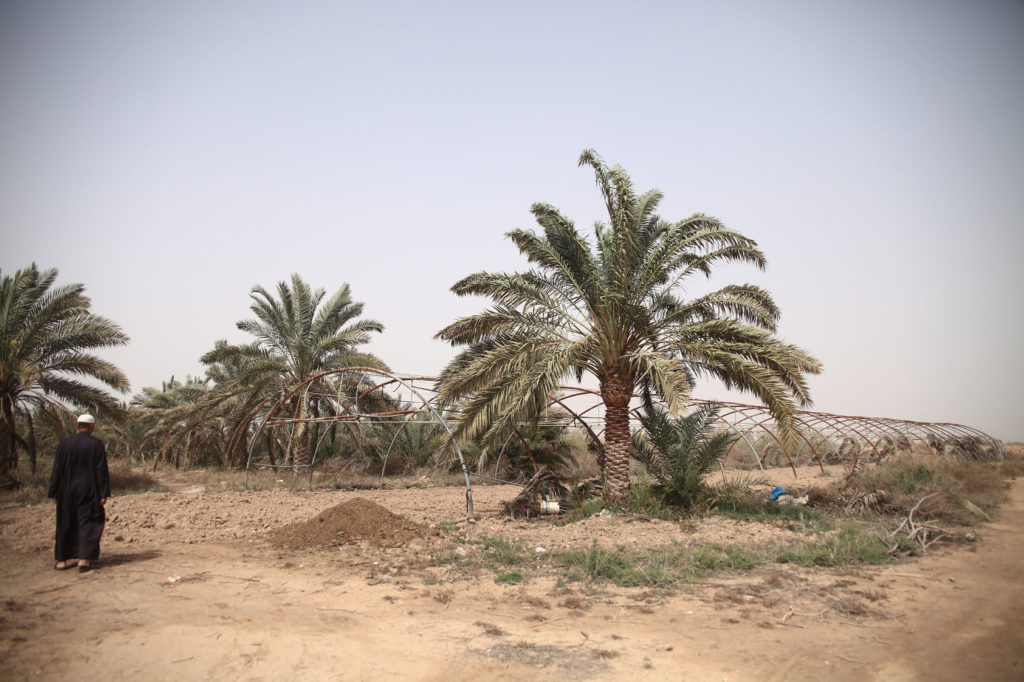
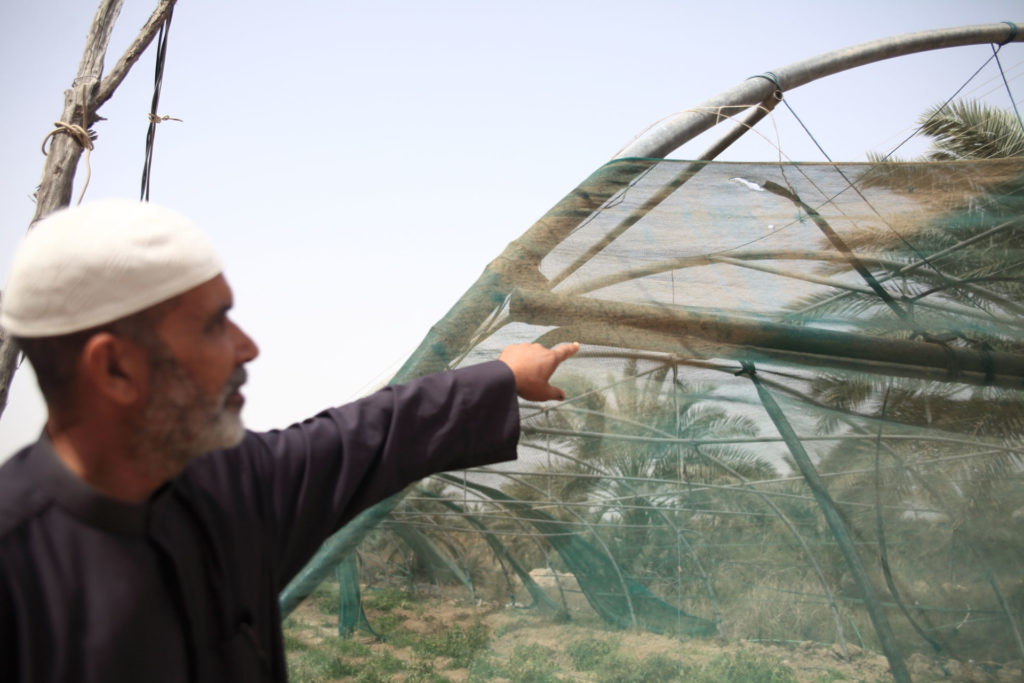
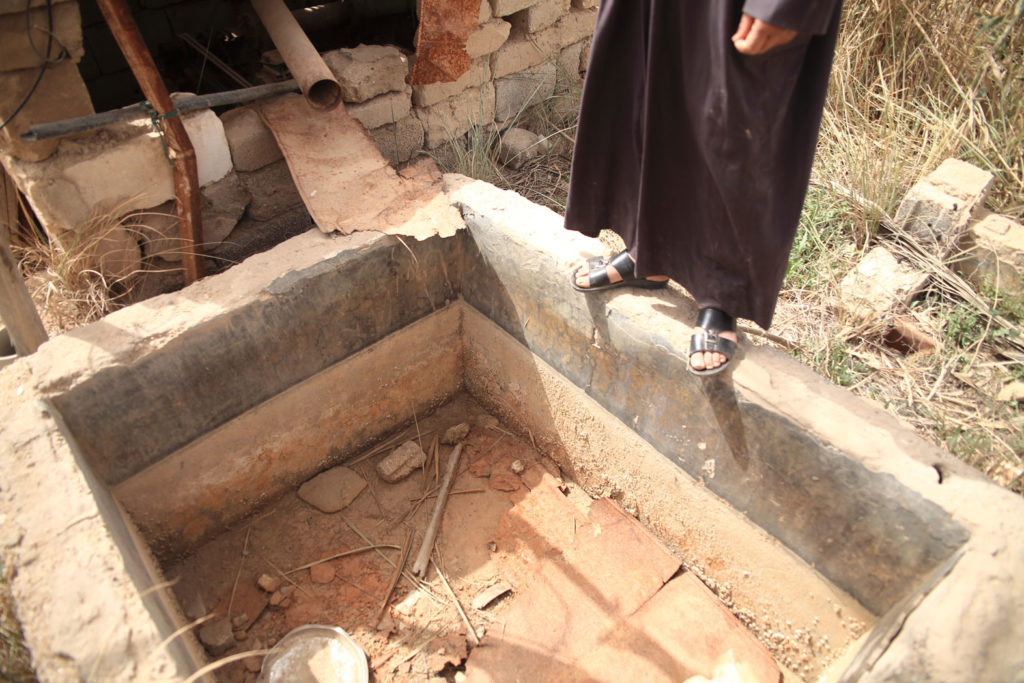
Ahmad Attasalah, 52, with a net in hand and his friend steering the boat, has been fishing since he was six with his father. Over time, he has seen the routes of the water change, and he stresses the water crisis in the marshes has become more obvious, particularly over the past year. “When the marshes get dry in other areas, the fish will come and gather in the areas that have water which means there are a lot of fishermen in one small area, so it gets competitive. It’s not stable,” Attasalah says. Looking at the marshes now, he feels a pang of sadness because of how much it has changed over time. “The place used to be much more beautiful, the people were different, the color of the place was different, everything was so green. For me, these are not the marshes anymore.”
Living in the marshes near Al Chibayish, 32-year-old Umm Ali sets out each morning at 3 or 4 a.m. to catch as many fish as she can to sell at the market. She is the sole supporter of her six children, five of whom are still in school, after her husband passed away last year. “We won’t be able to live if I don’t fish, but there is certainly a decrease in the number of fish I can catch,” she says, sitting in her boat. “I’m worried about the marshes being almost dry [in the summer] because of the cut of water [from the dams], but what can I do, we’re just going to have to beg for money.”
The contamination and pollution from the oil industry, medical industry and urban sewerage, coupled with the drainage of salts from farmlands into the Euphrates and Tigris, is also deeply affecting the buffaloes, which are the main economic unit of the marshes. Without fresh water they will turn blind and die.
“The lack of regular annual flooding of the marshlands with freshwater means the quality of water is not good for survival of the ecosystem and the existence of species and human life is endangered,” says Ahmad from UNDP.

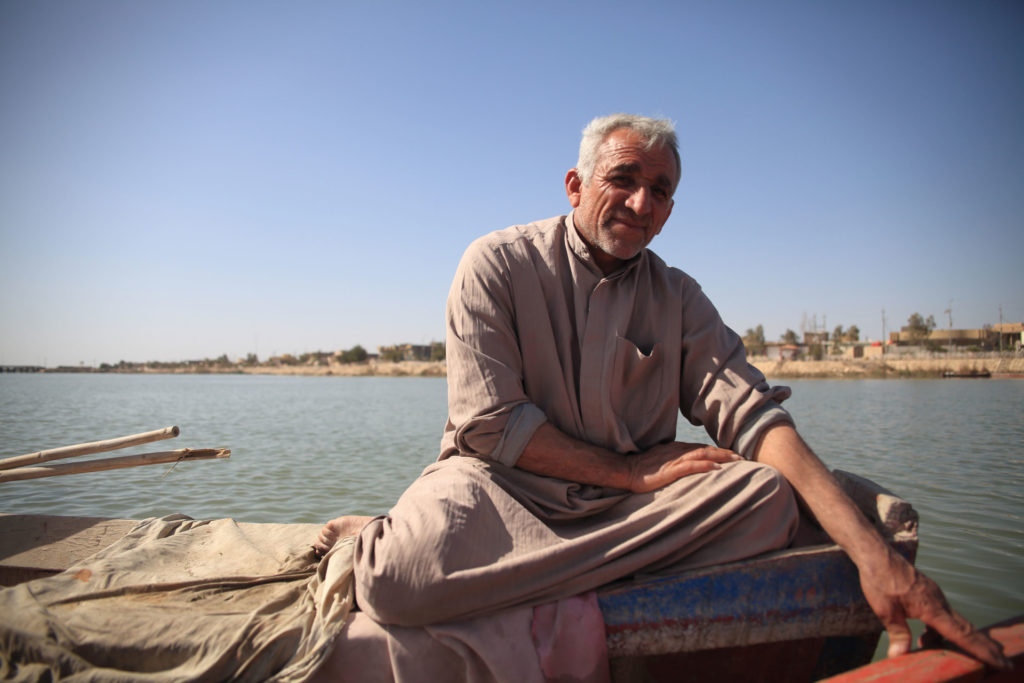
Living in a reed hut in the middle of the marshes, Fatima doesn’t offer her last name, but lovingly starts pointing to her buffaloes and introduces them one by one: Baraka, Suada, Nijma … “I love them more than I love myself. I raised them and I care for them every day. They’re my soul,” she says. While she has 10 buffaloes to keep her company, she lives by herself in a small reed house; her parents have passed away and her brothers married and left for the city of Chibayish. Fatima is tired from working on her own for many years, forcing her to stop fishing. She also can’t sell milk anymore because she can’t afford the $40 bag of wheat to feed the buffaloes, and so the buffaloes stopped producing milk.
Her biggest concern is how salty the water is in the marshes now and that the buffaloes can’t drink from it. “I have to start buying water from Chibayish for the buffaloes and myself to drink,” Fatima says. But every time they fill her tank, it costs $10 to $12. Last year, she had to use the water from the Euphrates for the summer, but it was extremely salty. She has been told that this year, in the marshes where she lives, it could be dry for a few months.
“It means I don’t have anywhere else to go,” she says. “I don’t know what to do. Water is life for us. If it’s gone, we are gone.”
